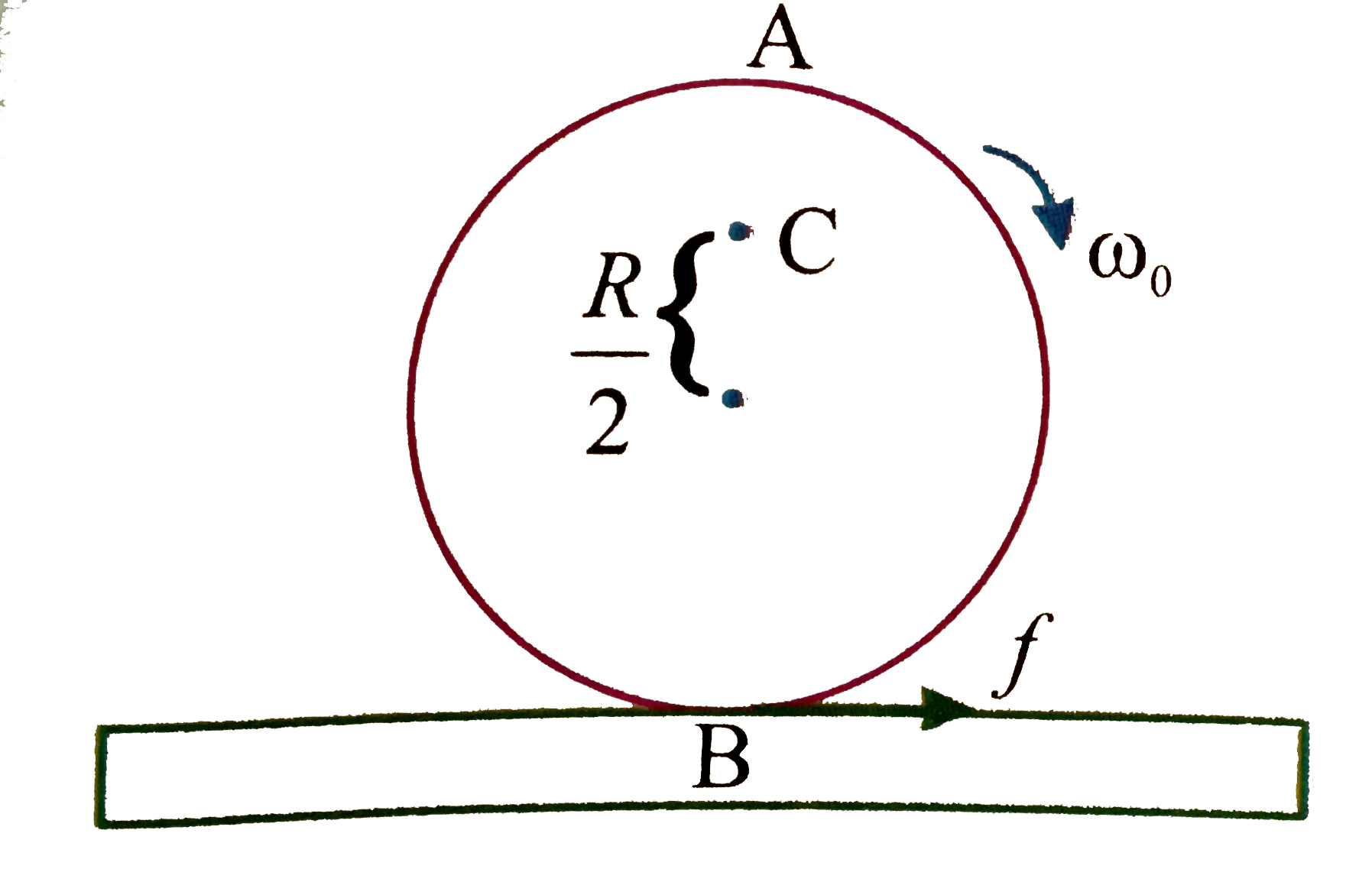A solid cylinder of mass 20kg and radius 0.12m rotating wit initial angula speed of 125rad/s is placed lightly (i.e. without any translational push) on a horizontal table with coefficient of kinetic friction μk=0.15 between the cylinder and the table.
(a) After how long does the cylinder start rolling ?
(b) What is the initial translational energy, rotational energy and total energy of the cylinder ?
(c) What is the final (i.e. after rolling begins) translational energy, rotational energy and total energy of the cylinder ? (d) Is the finl total enrgy equal to the initial total energy of motion of the cylinder ? If not, where does the difference of energy disappear ?
(e) Account for the loss of total energy of motion in the following way : find the work done by friction on the body its translational motion. Show that net work done by friction on the body is negative, equal in magnitude to the loss of total energy calculated in (d) above.
Here, m=20kg,r=0.12m,ω0=125rad/s,μk=0.15
(a) As discussed already in Q.30, page 5/114, time after which the cylinder stars rolling is
t=rω03μkg=0.12×1253×0.15×9.8=3.4s
(B) Initial translational energy =0 (∵u=0)
rotational energy =12Iω20=12(12mr2)ω20=14×20(0.12)2(125)2=1125J
total energy of the cylinder =0+1125=1125J
(c) As α=μkmgRI=μkmgR12mR2∴α=2μkgR=2×0.15×9.80.12=24.5rad/s2
Rolling begins, when v=rω
Now ω=ω0−αt=125−24.5×3.4=41.7rad/s
v=rω=0.12×41.7=5.004m/s
∴ final translational energy =12mv2=12×20(5)2=250J
final rotational energy =12Iω2=14mr2ω2=14×20(0.12)2(41.7)2=125J
final total energy =250+125=375J
(d) No. Loss of energy =1125−375=750J
(e) Work done by friction for translational motion =+250J
Taking, θ=ω0t=12αt2=125×3.4−12(24.5)(3.4)2=425−141.61=283.39radian
Work done by friction against rotational motion =−μkmgr×θ
=−0.15×20×9.8×0.12×283.39=−1000J
Thus net work done by friction on the body =250−1000=−750J
This accounts for the loss of energy in (d) above.
Topper's Solved these Questions
- SYSTEMS OF PARTICLES AND ROTATIONAL MOTIONBOOK - PRADEEPCHAPTER - SYSTEMS OF PARTICLES AND ROTATIONAL MOTIONEXERCISE - VALUE BASED QUESTIONS
5 Videos
- SYSTEMS OF PARTICLES AND ROTATIONAL MOTIONBOOK - PRADEEPCHAPTER - SYSTEMS OF PARTICLES AND ROTATIONAL MOTIONEXERCISE - CURIOSITY QUESTIONS
4 Videos
- SYSTEMS OF PARTICLES AND ROTATIONAL MOTIONBOOK - PRADEEPCHAPTER - SYSTEMS OF PARTICLES AND ROTATIONAL MOTIONEXERCISE - ADDITIONAL EXERCISES
11 Videos
- RAY OPTICSBOOK - PRADEEPCHAPTER - RAY OPTICSEXERCISE - Problem For Practice(a)
25 Videos
- THERMODYNAMICSBOOK - PRADEEPCHAPTER - THERMODYNAMICSEXERCISE - Assertion- Reason Type Questions
19 Videos
Similar Questions
A disc rotating about its axis with angular speed ω0 is placed lightly (without any translational push) on a perfectly frictionless table. The radius of the disc is R. What are on the disc shown . Will the disc roll in the direction indicated?

View SolutionA solid disc and a ring, both of radius 10cm are placed on a horizontal table simultaneously, with initial angular speed equal to 10πrad/s. Which of the two will start to roll earlier ? The coefficient of kinetic friction is μk=0.2.
View Solution
Knowledge Check
A solid cylinder of mass M and radius R rotates about its axis with angular speed ω. Its rotational kinetic energy is
A12MR2ω2BMR2ω2C14MR2ω2D18MR2ω2A ring of radius R is rotating with an angular speed ω0 about a horizontal axis. It is placed on a rough horizontal table. The coefficient of kinetic friction is μk. The time after it starts rolling is.
Aω0μkR2gBω0g2μkRC2ω0RμkgDω0R2μkgAn solid cylinder of mass 20kg and radius 20cm rotates about its axis with a angular speed 100rads−1. The angular momentum of the cylinder about its axis is.
A40 J sB400 J sC20 J sD200 J s
A ring of radius R is rotating with an angular speed ω0 about a horizontal axis. It is placed on a rough horizontal table. The coefficient of kinetic friction is μk. The time after it starts rolling is.
View SolutionA solid cylinder of mass 1 kg and radius 0.02 m, is rolling on a smooth horizontal surface with a uniform velocity of 0.1 m/s. Its total energy is
View SolutionA solid sphere of radius r r is rolling on a horizontal surface. The ratio between the rotational kinetic energy and total energy.
View SolutionA solid sphere is moving on a horizontal plane. Ratio of its translational kinetic energy and rotational kinetic energy is
View SolutionA disc is rolling on a surface without slipping. What is the ratio of its translational to rotational kinetic energies ?
View Solution
